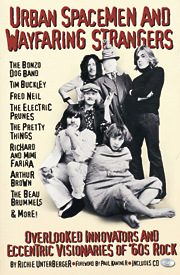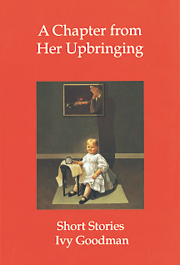Recalling some forgotten performers of rock’s real “glory days.”
By Leonard Gontarek

URBAN SPACEMEN AND WAYFARING STRANGERS:
Overlooked Innovators and Eccentric Visionaries of ’60s Rock
By Richie Unterberger C’82.
San Francisco: Backbeat Books, 2000.
400 pgs. (plus CD); $22.05.
Order this book
There was a TV show on recently: The Sixties. I missed it. That’s the second time. If you’re like me, Richie Unterberger’s Urban Spacemen And Wayfaring Strangers: Overlooked Innovators and Eccentric Visionaries of ’60s Rock is another chance to visit the decade. It’s as eccentric and sprawling and opinionated and obsessive as its mouthful of a title suggests. And that’s praise in this case.
Urban spacemen and wayfaring strangers—what does that all mean, anyway? It means biographies of Fred Neil, Bobby Fuller, Mike Brown, The Electric Prunes (19 subjects in all). Never heard of them? You’ve heard their songs. Dozens of times. Bobby Fuller: “I Fought The Law (And The Law Won).” Fred Neil: “Everybody’s Talkin’ At Me.” From Midnight Cowboy? You know you’re humming it. Next you’ll have me believe you never played air guitar.
The appearance of Unterberger’s book at this time makes a lot of sense. The revered and influential in rock is constantly shifting. Take Johnny Cash. He’s spoken of in hushed tones. With sales to back it up. And I don’t mean with country fans. We’re talking about Pearl Jam’s and Rage Against The Machine’s fan base. My own son (six-years old) is devoted to David Byrne and Jethro Tull. I don’t even listen to Jethro Tull.
If you hate flying and Richie Unterberger was seated next to you, greased on a couple of vodkas, or whatever greases him, his would be a welcome distraction. You might go first for Richard and Mimi Farina (“Been Down So Long It Looks Like Up To Me”) or the Beau Brummels (you may have even dressed like them for a brief period you remember fondly, but categorically deny). Whatever your approach, you’ll find yourself hooked and going deeper.
I didn’t know much about The Fugs, though I had heard of them—with a name like that … The Fugs may be the strangest of all Unterberger’s wayfarers, as he puts it. The credo “sex, drugs & rock and roll” may be more accurately put in their case as “sex, drugs & revolution.” Their roots were in the 1960s folk movement and 1950s Beat poetry; they were participants in civil rights and peace marches. On the other hand, obscenity was a staple in their song-writing: goofy, subversive, taboo-shattering classics of a kind. Freedom was their cry, for which they were promptly met with establishment harassment.
They might have been anti-stars, but they made themselves famous all the same. Apparently, their only nod to professionalism was when they managed to show up for their gigs on time. But in sexual, political lyrics, they were unmatched, with deadly serious intentions, as in their standards, “Kill For Peace” and “Dirty Old Man.” As their most widely known member, and renaissance man for the 20th century, Tuki Kupferberg says (accurately), “[W]e were part of making pop music able to sing about anything.”
Unterberger’s program is less where-are-they-now?than where-were-they-then? If you have a healthy curiosity and interest in music, haven’t you wondered where that sunrise of a song “Just Walk Away Renee” came from, or scoffed at how much Lenny Kravitz or heavy metal is beholden to The Crazy World of Arthur Brown. You must have wondered what was the skinny with The Bonzo Dog Band. Then put this book next to your Penguin Guide To Jazz.
I went right for Tim Buckley (father of current cult favorite singer-songwriter Jeff Buckley). Here was a voice of undeniable range, a gifted and ambitious songwriter, signed to a progressive, visionary label. Yet, even with a significant audience, he cannot be considered successful. The failure of his musical experiments to gain a wider audience may have contributed to his death by overdose. Arguably—and I would be among those arguing—as with most genius, his was before its time. The mystery of Tim Buckley is not unraveled in this book, but it is a fascinating read, anyway. It did send me back to his music, where the truth and dark secrets of this troubadour’s imagery resides.
The book includes a CD. This critic gives it three *** stars. Rating: * Should have downloaded it. ** Should have shoplifted it. *** Very Good. **** Great. The cuts include Richard and Mimi Farina’s “Reno Nevada”. The singing and arrangement is the first breeze, warm and scented, in Spring through a screen. The Fugs’ “Kill For Peace” is a demented Byrds’ song; hard to tell which came first, Dylan or the egg. “Too Much To Dream” is indeed a dream by The Electric Prunes: like the day you open all the windows, crank the volume, and hit repeat three or four times. Thee Midniters’ “Jump, Jive & Harmonize” is cooool water, nostalgia in the best sense. Makes you jot down two or three other songs from the period to search for later. Bobby Fuller’s “Never To Be Forgotten” will become your favorite song of the week. You’ll cop some lyrics to get you through the hole in the middle of the day.
With apologies to Bruce Springsteen, these were rock’s “glory days.” The artists Unterberger features are not the Beatles and Dylan, but who is? Given the rich, unparalleled mastery of rock output of the time, to attain even a fraction of that artistic and commercial success put you miles ahead of what passed for genius in rock and pop music in the decades to follow, in Unterberger’s view. There’s a conversation-igniter next time you prop your elbows up on a coffee bar or are flipping through Entertainment Weekly in a doctor’s waiting room.
No doubt, this is a fascinating crew assembled here, with legitimate claims to the classic in rock. In his foreword to the book, Paul Kantner writes that he tried, as a member of Jefferson Airplane, to establish something as real to his own experience as Fred Neil’s music was to his. This is likely the role of music to our lives. All the better that it be individual, inventive, eccentric, indefatigable—just like us.
Leonard Gontarek is the author of Van Morrison Can’t Find His Feet and Zen for Beginners. His work has appeared in The Quarterly, Exquisite Corpse and American Writing. He is a contributing editor to the American Poetry Review.
Just Life
Stories of “abundant originality and festering clarity.”
By Beth Kephart

A CHAPTER FROM HER UPBRINGING
By Ivy Goodman CW’75.
Pittsburgh: Carnegie Mellon University Press
223 pages; $15.95 (paperback).
Order this book
I’d never heard of Ivy Goodman until I came into possession of her new short story collection, but within an hour or two of settling in with her work, I was regretting that I’d come so late to the acquaintance. Like Alice Munro, Ann Beattie, and Lorrie Moore, Goodman has an extraordinary amount to say about seemingly ordinary lives.
Like Chekhov, she needs and fashions no stylistic pyrotechnics to tell her tales. Like Elias Canetti, she is not afraid to blur the line between the fantastic and phantasma.
The thoughts that go unspoken appear to be Goodman’s primary terrain. The arguments we have with ourselves when no one is looking, or the arguments we remember having, or the arguments we lack the courage to be having: she makes us privy to them all. The mind, in other words, and the way the mind tortures itself is Goodman’s specialty, so that readers coming to her work should expect neither complicated plot lines nor incidental action. No sweeping landscape vistas. No trendy period pieces. Just life.
“Short-Lived,” the first of the 16 stories in the collection, is also perhaps the best, a tale so well-conceived and executed that it left me short of breath. In a mere 16 pages, Goodman fuses her protagonist—middle-aged Kate Bergen—with an ugly, disquieting memory from Kate’s heretofore buried past. She makes Kate vulnerable to her own history.
It is the shock of a photograph found among a pile of old magazines that catapults Kate backward to her seminal year just after college. She’d fashioned herself an artist back then, though she understood, even at 22, that she wasn’t working hard enough, that she “fretted and dawdled,” that she was, in fact, an artist manqué. Kate’s roommate, Paula, was the real artist between the two of them, for Paula was, as Goodman so marvelously puts it, “reckless, and Kate, in her little room below, was safe, with all the implied condemnation of safety in art.”
It was the dark and sensuous poet Arthur Adler who disturbed the tenuous balance of that year. Hoping to draw his portrait, hoping, more truthfully, to seduce him, Kate failed at both, and the memory, rushing back, is bruised and brutal. “She didn’t ask him if his aim all along was to prove she couldn’t draw,” Goodman writes about the aftermath of Adler’s pointed reprehension. “If she used art as a means to seduce, then he used sex, just as wrongly, as a means to moralize.”
But there is more to the story than that, there is always going to be far more to Goodman’s stories than that, and as Kate’s memory wends itself back, we watch her watch herself as she meets up with Adler once again. Paula’s boyfriend is dying by then; Adler has come to the apartment to pay respects. And in the selfish way that dying affects the young, Kate twistedly longs for Adler’s physical comforts. Her neediness prompts his accusations. His accusations prick and pain, even all these anonymous years later.
What makes “Short-Lived” so impeccable is not just the odd yet somehow familiar slate of characters or the absorbing quality of the tale or the stunning sequences of sentences with which Goodman paints her portraits. What makes it so impeccable is what makes all these stories so impeccable—Goodman reaches deep into her protagonist’s psyche and returns with revelations that feel universal, true.
The following passage is characteristic of so many passages that grace the whole collection—incisive, startling, heartrending, memorable:
Even now, in middle age, she preserved the vital though self-deceptive hope that anything might change and nothing need be done meanwhile. She still had a kind of vision, she still could see, and she still was moved by perceptions as poignant as consciousness. But nothing came of it; nothing was expressed. She had fallen to a place where people worked at tolerable but not thrilling work, a lifetime of work whose chief reward and motivation was (never quite enough) money. If she died tomorrow, she would leave behind no aborted masterpiece.
It is not Goodman’s habit to rescue her characters from their fantasies, their complexities, the noisy harangues inside their heads. It is not her way to make them easy or palatable.
The characters here are lonely, sleep-deprived, estranged, and mostly, they are steeped inside regret. In “Eating Him Alive,” we meet a fat man, from a fat and increasingly insensitive household, who begins to starve himself to death: “He believed he was then in the stage of smell. He still had a lot to lose, a lot of flesh to gas off. His aim was his whole body contracting tight to its bones, like the inside of a parched person’s mouth, clinging drily to the teeth.” The ending is a fusion of the surreal and the tragic, a shock, even though Goodman has unassailably prepared us for it.
In “Memorial Gardens,” Goodman’s heroine is a new mother who cannot sleep and who cannot love and who has thrown herself upon buried strangers in a cemetery that, on impulse, she’s driven to. “Now she lay on a stranger’s grave and recalled the last months with scorn at her naivete and her immersion in them but also with respect for the woman—as though not herself—who had endured and survived with enough good sense not to have another baby, a promise that both shamed and spurred her, like an alcoholic’s secret stash of whiskey.” What will become of the heroine? We don’t know. We only know what she is battling in the combat zone of her weary head.
Goodman’s stories are inventive, disturbing, hypnotic, quotable; they are blessed with two attributes that aren’t often found welded together: abundant originality and festering clarity.
Recognized by the Fine Arts Work Center in Provincetown, the National Endowment of the Arts, the Maryland State Arts Council, the O’Henry Awards, and the Iowa Press Award series, among other organizations, these are stories that are destined to endure. This is an author who deserves wide appreciation.
Beth Kephart C’81 is the award-winning author of Into the Tangle of Friendship and A Slant of Sun. She is at work on a third memoir.
BRIEFLY NOTED
A selection of recent books by alumni and faculty, or otherwise of interest to the University community. Descriptions are compiled from information supplied by the authors and publishers.
INVESTING IN THE NEW EUROPE
By Eric Uhlfelder C’79.
Princeton, N.J.: Bloomberg Press, 2001. 331 pp., $29.95.
Order this book
How are investors to view today’s Europe? Analysts predict that European economies will outpace the United States over the next decade. They see a number of European companies surging past their American competitors and becoming dominant global market movers. They also recognize strong industry sectors with as yet untapped technological potential. The individual investor who is trying to understand the evolving economics and politics of Europe today is overwhelmed by complex and often contrary information. This book provides a resource for investors to identify Europe’s expanding opportunities. Eric Uhlfelder has been covering international markets as a writer and analyst for more than 10 years.
FORMS OF CONSTRAINT:
A History of Prison Architecture
By Norman Johnston Gr’58.
Urbana, Ill.: University of Illinois Press, 2000. 200 pp., $34.95.
Order this book
This book traces the architecture of prisons worldwide from ancient Roman dungeons to modern structures. Trends in prison design are set in the context of political and social events of the time and society’s changing ideas about the purpose of imprisonment, giving special attention to the influences on design and penal treatment which have emanated from one country to another, particularly in the 19th century. Dr. Norman Johnston is professor emeritus of sociology at Beaver College.
THE LIES THAT BIND
By Edward DeAngelo C’77.
New York: William Morrow, 2001.336 pp., $24.00.
Order this book
Business executive Peter Morrison and his ex-wife, Joan, an artist, were never right for each other. Nonetheless, when their marriage failed after eight years, Pete was devastated. He couldn’t imagine not sharing his home and day-to-day life with his young son, Sam. Five years later Pete still lives for his visits with 13-year-old Sam. But Pete has been plagued by nagging doubts about their connections, as they’ve never shared physical similarities or common interests. So when an opportunity arises to take a paternity test, he seizes it—and, in this novel, discovers his worst fears are true. Overcome with anger, Pete confronts his ex-wife who strikes back by cutting off visitation rights. Suddenly Pete finds himself without a son—and without a father’s legal right to get the boy back. Desperate for a solution he brings a lawsuit that breaks new legal ground in defining what a father is. Edward DeAngelo lives in Boston and works in the Massachusetts attorney general’s office.
THE JPS BIBLE COMMENTARY: Esther
By Adele Berlin CW’64, Gr’76.
Philadelphia: The Jewish Publication Society, 2001. 176 pp., $34.95.
Order this book
The Book of Esther is, among Jews, one of the best-known and most enjoyed books of the Bible. Its fame is due almost entirely to its connection with Purim. Whether the book preceded the festival or the festival the book, the two are inextricably bound together. The Book of Esther is a joyous book for a joyous festival. Dr. Adele Feigenbaum Berlin’s work provides a critical line-by-line commentary of the biblical text, which is presented in its original Hebrew, complete with vocalization and cantillation marks. As in the other commentaries of the Jewish Publication Society series, the Hebrew is paired with the 1985 JPS English translation of the Holy Scriptures.
HEART TO HEART:
Deepening Women’s Friendships at Midlife
By Patricia Gottlieb Shapiro SW’68.
New York: Berkley Books, 2001. 240 pp., $13.00.
Order this book
Friendships move to center stage at midlife, after years of having been set aside for children, husbands, and careers. As women try to make sense of the kaleidoscope of changes within them and around them—especially the physical and emotional upheavals and shifting family ties—their friends keep them anchored and grounded. Not since their teen years have friends been so crucial to women’s lives. This book explores why friends matter at midlife, the powerful nature of the bond and its roots and challenges. Patricia Shapiro interviewed 50 women aged 45-60 and blended their stories with research, expert commentary, and her own personal experience. She is the author of four other non-fiction books, including My Turn: Women’s Search for Self After the Children Leave, and is a frequent speaker on women’s midlife issues.
FIXED: How Goodfellas Bought Boston College Basketball
By David Porter C’82.
Dallas: Taylor Publishing Co., 2001. 272 pp., $24.95.
Order this book
College basketball has nearly outstripped the Super Bowl as the most heavily bet
sporting event, bringing even Mafia involvement to the game. In Fixed, David Porter focuses on a specific manifestation of this corruption: the point-shaving scandal involving the 1978-79 Boston College basketball team. Through first-hand interviews and copious research, David Porter, a sportswriter and columnist, details how the scheme began in the Summer of 1978 and remained unknown until an unrelated investigation exposed it in 1980. He also illuminates the fall 1981 trial in which mobsters, NCAA officials, players, and coaches went head-to-head in a scene that seemed more like a movie than real life.
APOLLO’S LEGACY:
The Hellenic Torch in America at the Dawn of the New Millennium
By Effie Lascarides.
Brookline, Mass.: Hellenic College Press, 2000. 284 pp., $39.95.
Order this book
This book features in-depth interviews with 16 accomplished Greek-Americans, including Dr. P. Roy Vagelos C’50 Hon’99, emeritus trustee, former chair of the University’s trustees and former chair of Merck Pharmaceuticals. Other success stories include Helene Alexopoulos, prima ballerina with the New York City Ballet; George Stephanopoulos, TV commentator and former advisor to President Clinton; and Alex Spanos, owner of the San Diego Chargers.
LOVE NOTES
By Leslie Esdaile W’80.
BET Books, 2001. 288 pp., $5.99.
Order this book
Artist Nina Carpenter knows her marriage is in trouble and blames her husband Tony’s late nights at his jazz club. When the club is robbed and his brother is murdered, Tony decides to sell his business and save his marriage, but love is tested when a prospective buyer comes into the picture. Leslie Esdaile has worked with Fortune 100 companies in corporate marketing and sales, and independently with small businesses. She is currently director of Competitive Edge Initiatives for Ben Franklin Technology Partners of Southeastern PA and recently graduated from Temple University with a master’s degree in filmmaking. Her other novels include Sundance, Midnight Clear and Slow Burn.
DEVICES AND DESIRES: Gender, Technology, and American Nursing
By Margarete Sandelowski Nu’69.
Chapel Hill, N.C.: The University of North Carolina Press, 2000.
288 pp., $19.95.
Order this book
Nursing and technology have been inexorably linked since the beginnings of trained nursing in the United States in the late 19th century. Whether or not they thought of the devices they used as technology, nurses have necessarily used a variety of tools, instruments, and machines—from thermometers to cardiac monitors—to appraise, treat, and comfort patients. Tracing the relationship between nursing and technology from the 1870s to the present, Dr. Margarete Sandelowski argues that technology has helped shape and intensify persistent dilemmas in nursing and that it has both advanced and impeded the development of the profession. She demonstrates that nurses both embraced and rejected technology in their pursuit of cultural visibility and professional autonomy—with varying amounts of success. As one of the domains of work historically most subject to sex segregation, Sandelowski notes, nursing provides an ideal site in which to examine the interplay of technology and gender. Sandelowski is professor of nursing at the University of North Carolina at Chapel Hill and a Fellow of the American Academy of Nursing.
THE SHOTOKU TEAHOUSE
By Richard Mumford C’54 and Keiko Mumford.
New York: xlibris/Random House, 2001.
445 pp., $25.00 (cloth); $16.00 (paper).
Order this book
This book tells the story of Richard and Keiko, two young people of dramatically different backgrounds who grow up in their separate cultures—the United States and Japan—go through the war years of the 1940s as bitter enemies, then meet, and begin, with uncertainty and much hesitation, to learn about and love each other. Finally, struggling against great odds, they marry and move to the United States where Keiko encounters a society very different from her own. Dr. Richard Mumford taught history for 40 years, the final 35 as professor of history at Elizabethtown College in Lancaster County, Pa. Keiko Mumford taught nursery school in her church and has presented Japanese culture to many school children throughout central Pennsylvania.
REMEMBERING THE LOWER EAST SIDE
Edited by Hasia R. Diner, Jefferry Shandler and Beth Wenger, Faculty.
Bloomington, Ind.: Indiana University Press, 2001. 304 pp., $24.95.
Order this book
When it functioned as an apartment building, 97 Orchard Street was home to some 10,000 residents, most of them Jews. In its current incarnation as site of New York’s Tenement Museum, the address has taken on mythic significance. It has become the repository of memory, specifically the unique history of American Jews, whose current lives are very different from those European relatives who may have resided at or near that address. This book explores the dynamics of Lower East Side memory and considers the changing ways that this unique neighborhood has been embraced by American Jews over the course of a century. Dr. Beth Wenger is assistant professor of history and holds the Katz Family Chair in American Jewish History. She is the author of New York Jews and the Great Depression and co-editor of Encounters with the “Holy Land”: Place, Past and Future in American Jewish Life.
THE GAME OF LIFE: College Sports and Educational Values
By James Shulman and William Bowen.
Princeton, N.J.: Princeton University Press, 2001. 430 pp., $27.95.
Order this book
The effect of college sports on the admissions policies and campus life of American higher education has been debated for decades. In recent years, however, with clear commercialization of college sports teams and accusations that many universities are accepting less academically qualified students on the sole basis of athletic ability, intercollegiate athletics have come under intense scrutiny. This book, written by former Princeton University president Dr. William Bowen and Dr. James Shulman, offers evidence that the hold athletics have on the American university system is stronger than ever: Athletes recruited by top universities do, in fact, enjoy a substantial advantage in the admissions process. With the exception of students at women’s colleges, while enrolled in college, athletes tend to do less well academically than their non-athlete peers. Total athletic expenditures can reach the $50 million mark for Division IA teams and well into the millions for Ivy League and Division III schools. Shulman is the financial and administrative officer at The Andrew W. Mellon Foundation, where he has program responsibilities for research in higher education, and Bowen is president of The Andrew W. Mellon Foundation.
NUCLEASE METHODS AND PROTOCOLS
Edited by Catherine H. Schein, CW’74.
Totowa, N.J.: Humana Press, 2001. 525 pp., $125.00.
Order this book
Nucleases control the shape and activity of our genetic material. This book introduces readers to the wide world of nucleases, which range from “housekeeping enzymes” that cleave DNA and RNA at many positions to highly specific enzymes. Nucleases, long used as lab tools, are now serving as diagnostic and therapeutic tools. The 32 chapters in this book include contributions from 28 groups from leading industrial and academic research institutes in the United States, Europe, Australia, and Japan. Dr. Catherine H. Braun-Schein is now senior scientist and project coordinator at the Sealy Center for Structural Biology at UTMB Galveston.
IPOs FOR EVERYONE: The 12 Secrets of Investing in IPOs
By Linda Killian WG’79, Kathleen Smith WG’79, and William Smith WG’78.
New York: John Wiley & Sons, 2001. 256 pp., $27.95.
Order this book
The media has declared initial public offerings (IPOs) dead seven times in the past 10 years. According to the authors of this book, they’ve been wrong every time. Far from being deterred by the IPO obituaries, this book shows that such proclaimed hard times in the IPO market consistently present the best buys. No longer reserved for a select group of Wall Street pros, there are now many opportunities for every individual investor to take advantage of the IPO groundswell. The authors, founders of Renaissance Capital in Greenwich, Conn., offer advice on how to avoid a bad IPO, what makes a good IPO, and more.
SOUL FOOD: 52 Principles for Black Entrepreneurial Success
By Robert L. Wallace ME’78
Cambridge, Mass.: Perseus Publishing, 2000. 245 pp., $24.00.
Order this book
Entrepreneurial success is an ongoing journey that involves more than just working capital and a business plan. It requires commitment, fortitude, and a lifetime of knowledge that most entrepreneurs manage to collect only after numerous pitfalls and missteps. Based on 52 true stories told by black and minority business owners, this book details the lessons they have learned. Each anecdote offers principles and strategies that are widely applicable for both emerging and experienced entrepreneurs. Robert Wallace is a business consultant and speaker who lectures extensively on the topics of minority and female entrepreneurship. He is chairman and CEO of the Maryland-based BiTH Technologies Inc. and founder of EntreTeach.com, LLC, a Web portal dedicated to serving entrepreneurs via interactive training. He is the author of Black Wealth: Your Road to Small Business Success.




